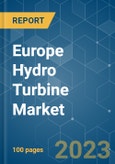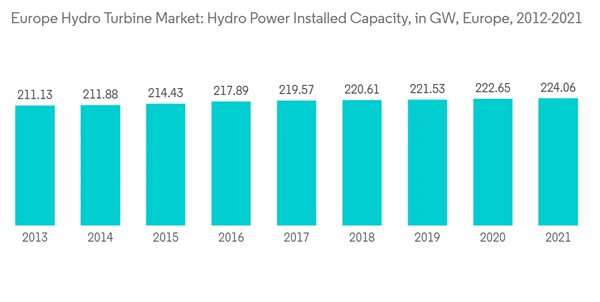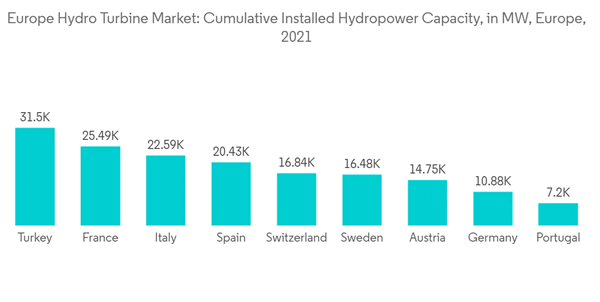COVID-19 negatively impacted the market in 2020. Presently the market has now reached pre-pandemic levels.
Key Highlights
- Over the medium term, factors such as increasing demand for energy, a rise in the need for cleaner technologies for power production, and stringent emission policy targets are likely to drive the hydro turbine market.
- On the other hand, certain drawbacks, such as design challenges of the turbine, ecological concerns related to dams, long gestation periods, and high installation cost of dams are hampering the growth of the studied market.
- Nevertheless, the rising requirement for renewable energy in emerging economies is anticipated to create a good growth opportunity for hydro turbine manufacturers. Emerging markets offer a potentially strong growth opportunity for renewable energy in the next few years.
- Norway is expected to be the largest market in the forecast period, with its high mountain plateaus, numerous natural lakes, steep valleys, and fjords, Norway's topography is well suited to hydropower development.
Europe Hydro Turbine Market Trends
Large (Greater than 100MW) segment to Dominate the Market
- A large-scale hydropower plant uses flowing water to drive huge water turbines to generate renewable energy. In order to generate significant amounts of hydroelectricity, lakes, reservoirs, and dams are required to store and regulate water for later release for power generation, irrigation, domestic use, and industrial use.
- Large-scale hydropower plants can be classified into several types: conventional hydroelectric dams, pumped storage, run-of-the-river, and tidal.
- A large-scale hydropower plant's cost depends on its natural surroundings, capacity, and the size of its urban centers. Civil engineering costs about 65-75% of the total cost, environmental regulations about 15-20%, and turbine, generator, and control systems make up the remaining 10%. According to International Renewable Energy Agency, during 2010-2021, the global weighted average installed cost of new Hydropower rose from USD 1,315/kW to USD 2,135/kW.
- Although large hydropower plants are expensive to install, they produce electricity at a low cost, especially in large cities. According to International Renewable Energy Agency, the global weighted average Levelized Cost of Energy (LCOE) of newly commissioned hydropower projects in 2021 was USD 0.048/kWh. In terms of fuel, operation, and maintenance, large-scale Hydropower is much cheaper than nuclear power, fossil fuels, and gas turbines. On average, Hydropower in the United States produces energy for less than USD 0.01 per kilowatt-hour.
- The construction of large-scale power plants is expensive, but their maintenance is low; dams must be operated and maintained by highly skilled professionals to ensure their safety.
- As of 2021, Hydropower continues to play an important role in the energy sector as Europe's second-largest renewable energy source. In 2021, 689 TWh of power was generated from European hydro sources.
- Hydropower generation in Europe has registered significant growth since 2012, with total installed capacity increasing from 209. 2 GW in 2012 to 224.06 GW at the end of 2021.
- In August 2022, Turkey's President inaugurated 34 hydroelectric power plants constructed by the State Hydraulic Works (DSI). A total of 34 hydroelectric power plants in 20 provinces will produce 2.3 billion kilowatt hours each year. These plants will provide an annual economic benefit of USD 150.3 million with an investment cost of USD 890.7 million.
- The above-mentioned factors are expected to drive the demand for hydro turbines over the study period.
Norway to Dominate the Market
- In Norway, hydropower accounts for the majority of power supplies, and production is largely dependent on precipitation levels, whereas, in other parts of Europe, the security of supply is primarily ensured by thermal power plants with fuels available on the energy market.
- In addition to having half of Europe's reservoir storage capacity, the Norwegian hydropower system offers a flexible production capacity of more than 75 percent. Production can be increased quickly and decreased as necessary, at a reasonable cost.
- Electricity production capacity is generally divided into two categories, flexible and intermittent. Power plants with flexible production can adjust their operations according to market conditions. Norway has many power plants with storage reservoirs, which make it possible to adjust production within the constraints of the licence and the watercourse.
- Hydropower is still the mainstay of the Norwegian electricity system. As of 2021, there were 1,682 hydropower plants in Norway, with a combined installed capacity of 33,391 MW. In a normal year, the Norwegian hydropower plants produce 136.4 TWh, which is 90 % of Norway's total power production. Norway produced approximately 143.7 terawatt hours of electricity from hydropower in 2021, a slight increase over the previous year.
- In May 2022, Statkraft, a renewable energy company opened two hydroelectric power plants Vesle Kjela and Storlia, which are located on opposite sides of the Hardanger mountain plateau, Norway. The Vesle Kjela power plant has a capacity of approximately 8.5 MW and produces approximately 40 GWh annually. According to the Sima regulation, the Storlia power plant utilizes a head of 75 meters between the Bjoreio river and Sysenvatn lake in the municipality of Eidfjord in order to achieve the same capacity and production.
- Therefore, based on the above-mentioned factors, Norway is expected to have a significant share in the Europe hydro turbine market during the forecast period.
Europe Hydro Turbine Market Competitor Analysis
The Europe hydro turbine market is moderately fragmented. Some of the key players in the market (in no particular order) include General Electric Company, Andritz AG, Litostroj Power Group, Siemens AG, Voith GmbH & Co. KGaA.Additional benefits of purchasing the report:
- The market estimate (ME) sheet in Excel format
- 3 months of analyst support
This product will be delivered within 2 business days.
Table of Contents
Companies Mentioned (Partial List)
A selection of companies mentioned in this report includes, but is not limited to:
- General Electric Company
- Andritz AG
- Litostroj Power Group
- Siemens AG
- Voith GmbH & Co. KGaA
- Kirloskar Brothers Ltd
- Canadian Hydro Components Ltd.
- Norcan Hydraulic Turbine Inc.
- Toshiba Energy










